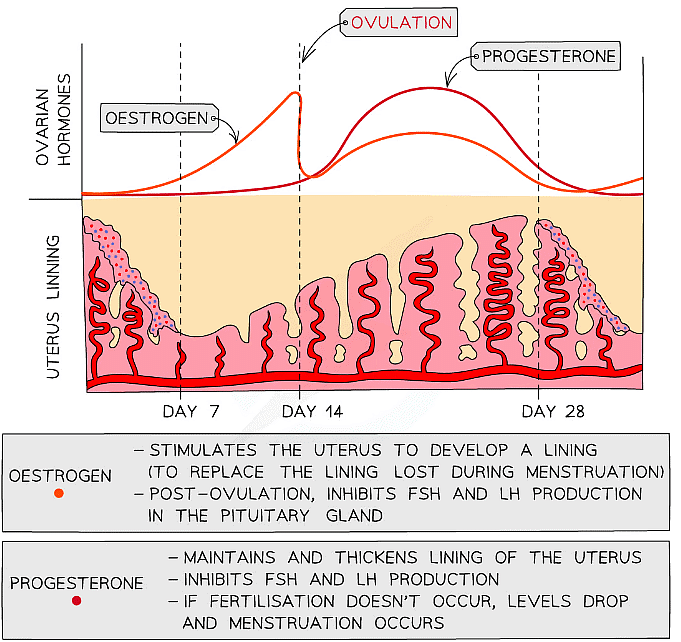Grade 10 Exam > Grade 10 Notes > Biology for Grade 10 > Hormones in Human Reproduction
Hormones in Human Reproduction | Biology for Grade 10 PDF Download
| Table of contents |

|
| Puberty |

|
| Hormones in the Menstrual Cycle |

|
| Interactions of the Hormones in the Menstrual Cycle |

|
| Hormone Level Graphs |

|
Puberty
- During puberty, reproductive hormones cause secondary sex characteristics to develop
- The main male reproductive hormone is testosterone which is produced by the testes; testosterone stimulates sperm production
- The main female reproductive hormone is oestrogen which is produced by the ovaries
- Oestrogen plays an important role in the menstrual cycle which begins at puberty, as well as causing physical changes to occur in the body (such as breast development)
- During the menstrual cycle, eggs in the ovaries begin to mature and one is released approximately every 28 days in a process called ovulation
Hormones in the Menstrual Cycle
Stages of the menstrual cycle
- During the menstrual cycle, the lining of the uterus builds up and ovulation occurs
- The average menstrual cycle is 28 days long and there are four overall stages:
- Menstruation – loss of lining from the uterus, occurs at the start of the cycle if no fertilisation has occurred
- The lining starts to thicken
- Ovulation occurs around the middle of the cycle (about day 14), the egg travels down the oviduct towards the uterus
- The lining is maintained ready to accept a fertilized egg
 Menstruation occurs at the start of the menstrual cycle, with an egg released around the middle
Menstruation occurs at the start of the menstrual cycle, with an egg released around the middle
Hormonal control of the cycle
- Four hormones control the events that occur during the menstrual cycle
- Two of these hormones are produced by the pituitary gland in the brain:
- Follicle-stimulating hormone (FSH) causes maturation of an egg in the ovary
- Luteinising hormone (LH) stimulates the release of the egg
- The other two hormones, oestrogen and progesterone are involved in maintaining the uterus lining with oestrogen being made by the ovaries and progesterone specifically by an empty egg follicle called the corpus luteum
Interactions of the Hormones in the Menstrual Cycle
Higher tier only
- The pituitary gland produces FSH which stimulates the development of a follicle in the ovary
- An egg matures inside the follicle and the follicle produces the hormone oestrogen – so FSH stimulates the production of oestrogen
- Oestrogen causes growth and repair of the lining of the uterus wall and inhibits the production of FSH
- When oestrogen rises to a high enough level it stimulates the release of LH from the pituitary gland which causes ovulation (usually around day 14 of the cycle)
- The follicle becomes a corpus luteum and starts producing progesterone
- Progesterone maintains the uterus lining (the thickness of the uterus wall)
- If the egg is not fertilised, the corpus luteum breaks down and progesterone levels drop
- This causes menstruation – commonly known as having a period
- If fertilisation does occur the corpus luteum continues to produce progesterone, preventing the uterus lining from breaking down (breakdown of the lining would prevent a pregnancy)
- Once the placenta has developed, it starts secreting progesterone and continues to do so throughout the pregnancy to maintain the lining
 Remember that hormones travel around the body in the bloodstream but only have an effect on a target organ
Remember that hormones travel around the body in the bloodstream but only have an effect on a target organ
 |
Download the notes
Hormones in Human Reproduction
|
Download as PDF |
Download as PDF
Hormone Level Graphs
- You need to be able to extract and interpret data from graphs showing hormone levels during the menstrual cycle:
 Changes in the levels of the pituitary hormones FSH and LH in the blood during the menstrual cycle
Changes in the levels of the pituitary hormones FSH and LH in the blood during the menstrual cycle - FSH (follicle-stimulating hormone) is released by the pituitary gland and causes an egg to
- start maturing in the ovary
- It also stimulates the ovaries to start releasing oestrogen
- The pituitary gland is stimulated to release luteinising hormone (LH) when oestrogen
- levels have reached their peak
- LH causes ovulation to occur and also stimulates the ovary to produce progesterone
 Changes in the levels of oestrogen and progesterone in the blood during the menstrual cycle
Changes in the levels of oestrogen and progesterone in the blood during the menstrual cycle - Oestrogen levels rise from day 1 to peak just before day 14
- This causes the uterine wall to start thickening and the egg to mature
- The peak in oestrogen occurs just before the egg is released
- Progesterone stays low from day 1 - 14 and starts to rise after ovulation
- The increasing levels cause the uterine lining to thicken further; a fall in progesterone levels causes the uterine lining to break down (menstruation)
The document Hormones in Human Reproduction | Biology for Grade 10 is a part of the Grade 10 Course Biology for Grade 10.
All you need of Grade 10 at this link: Grade 10
|
110 videos|93 docs|9 tests
|
Related Searches



























